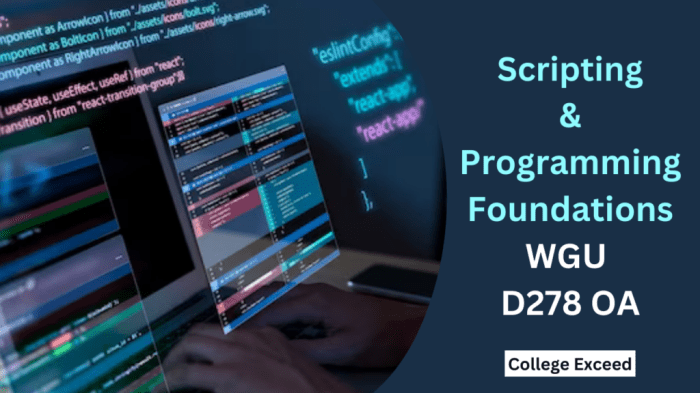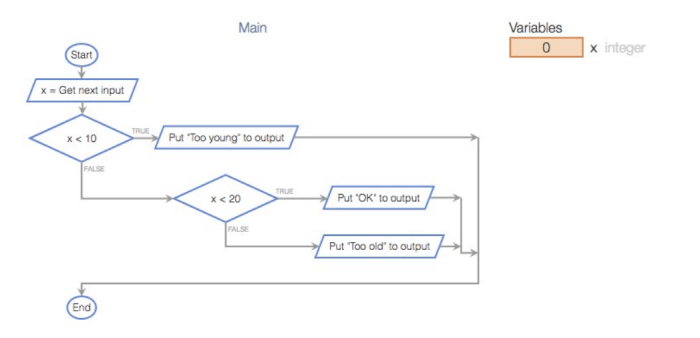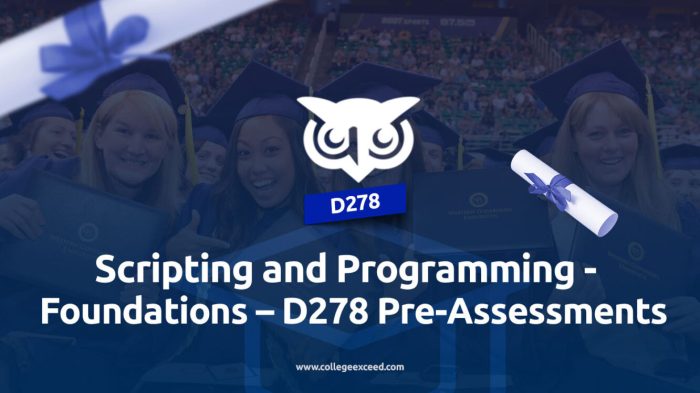Scripting and programming – foundations – d278 is a comprehensive guide to the fundamental concepts and techniques of scripting and programming. This course provides a solid foundation for individuals looking to develop their skills in these areas and gain a deeper understanding of the underlying principles.
Throughout this course, learners will explore the basic syntax and data types used in scripting and programming languages. They will also gain an understanding of control flow and logic, functions and modules, and object-oriented programming (OOP) concepts. Additionally, the course covers data structures and algorithms, debugging and error handling, and best practices and design patterns.
Introduction to Scripting and Programming Fundamentals

Scripting and programming are fundamental aspects of computer science that involve the creation of instructions and scripts to automate tasks and solve problems. Scripting languages are typically interpreted and designed for automating repetitive tasks, while programming languages are compiled and used for developing more complex and structured applications.
Examples of scripting languages include Python, JavaScript, and Bash, while examples of programming languages include Java, C++, and C#. Scripting and programming are essential skills in various fields, including software development, web development, data analysis, and artificial intelligence.
Basic Syntax and Data Types

The basic syntax of scripting and programming languages consists of s, operators, and statements that are used to construct programs. Different languages have their own unique syntax, but they share common elements such as variables, operators, and control flow statements.
Data types define the type of data that can be stored in variables, such as integers, floating-point numbers, strings, and booleans. Understanding data types is crucial for writing efficient and error-free code.
Control Flow and Logic
Control flow refers to the order in which statements in a program are executed. Control flow statements allow programmers to control the execution flow based on certain conditions or input.
Common control flow statements include conditional statements (e.g., if-else) and looping statements (e.g., while, for). These statements enable programmers to create complex and dynamic programs that respond to user input and handle various scenarios.
Functions and Modules
Functions are reusable blocks of code that perform specific tasks. They help in organizing and structuring code, making it easier to read, maintain, and reuse.
Functions can be defined with parameters to accept input and return values. Modules are collections of functions and variables that can be imported and used in other programs, promoting code reusability and modularity.
Object-Oriented Programming (OOP) Concepts

OOP is a programming paradigm that emphasizes the use of objects and classes to represent real-world entities. Objects have properties (data) and methods (functions) that define their behavior.
OOP concepts such as encapsulation, inheritance, and polymorphism allow programmers to create complex and maintainable code. OOP promotes code reusability, extensibility, and improved organization.
Data Structures and Algorithms: Scripting And Programming – Foundations – D278
Data structures are ways of organizing and storing data in memory. Common data structures include arrays, linked lists, stacks, and queues. Choosing the appropriate data structure for a given task is essential for efficient program execution.
Algorithms are step-by-step procedures used to solve specific problems. Understanding algorithms is crucial for optimizing program performance and developing efficient solutions.
Debugging and Error Handling

Debugging involves identifying and fixing errors in code. Debugging techniques include using print statements, breakpoints, and debugging tools.
Error handling mechanisms allow programmers to handle runtime errors gracefully and provide meaningful error messages to users. This ensures that programs can recover from errors and continue execution, improving user experience and program reliability.
Best Practices and Design Patterns
Best practices and design patterns are guidelines and reusable solutions that help programmers write clean, maintainable, and efficient code.
Best practices include using descriptive variable names, following coding conventions, and writing modular and reusable code. Design patterns are proven solutions to common programming problems, such as the Singleton pattern for ensuring that only one instance of a class exists.
Query Resolution
What are the prerequisites for this course?
This course assumes no prior knowledge of scripting or programming. However, a basic understanding of computer science concepts would be beneficial.
What are the benefits of taking this course?
This course provides a comprehensive foundation in scripting and programming, which is essential for a variety of careers in the tech industry. It also helps learners develop their problem-solving and critical thinking skills.
What are the career opportunities for individuals with scripting and programming skills?
Individuals with scripting and programming skills are in high demand in a variety of industries, including software development, web development, data science, and artificial intelligence.